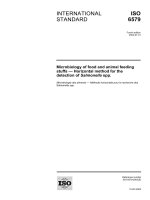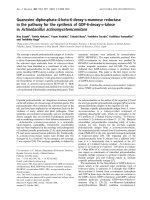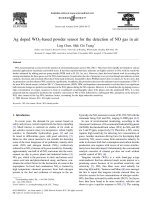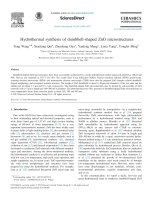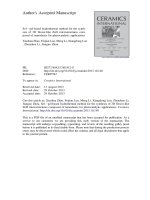solgel based hydrothermal method for the synthesis of 3d flowerlike zno microstructures
Bạn đang xem bản rút gọn của tài liệu. Xem và tải ngay bản đầy đủ của tài liệu tại đây (1.05 MB, 26 trang )
Author's Accepted Manuscript
SolÀ gel-based hydrothermal method for the synth-
esis of 3D flower-like ZnO microstructures com-
posed of nanosheets for photocatalytic applications
Xiaohua Zhao, Feijian Lou, Meng Li, Xiangdong Lou
, Zhenzhen Li, Jianguo Zhou
PII: S0272-8842(13)01412-0
DOI: />Reference: CERI7567
To appear in: Ceramics International
Received date: 13 August 2013
Revised date: 29 October 2013
Accepted date: 29 October 2013
Cite this article as: Xiaohua Zhao, Feijian Lou, Meng Li, Xiangdong Lou, Zhenzhen Li,
Jianguo Zhou, SolÀ gel-based hydrothermal method for the synthesis of 3D flower-like
ZnO microstructures composed of nanosheets for photocatalytic applications, Ceramics
International, />This is a PDF file of an unedited manuscript that has been accepted for publication. As a
service to our customers we are providing this early version of the manuscript. The
manuscript will undergo copyediting, typesetting, and review of the resulting galley proof
before it is published in its final citable form. P lease note that during the production process
errors may be d iscovered which could affect the content, and all legal disclaimers that apply
to the journal pertain.
www.elsevier.com/locate/ceramint
1
Sol
gel-based hydrothermal method for the synthesis of 3D flower-like ZnO microstructures
composed of nanosheets for photocatalytic applications
Xiaohua Zhao
a, b
, Feijian Lou
c
, Meng Li
b
, Xiangdong Lou
b, *
, Zhenzhen Li
b
, Jianguo Zhou
a, *
a
School of Environment, Henan Normal University, Xinxiang 453007, PR China
b
School of Chemistry and Chemical Engineering, Henan Normal University, Xinxiang 453007, PR China
c
School of Chemistry and Materials Science, Nanjing Normal University, Nanjing 210097, PR China
Corresponding authors. Tel.: +86 13 623731736; fax: +86 37 33326336.
Abstract: Self-assembled 3D flower-like ZnO microstructures composed of nanosheets have been
prepared on a large scale through a solgel-assisted hydrothermal method using Zn(NO
3
)
2
·6H
2
O, citric
acid, and NaOH as raw materials. The product has been characterized by X-ray powder diffraction
(XRD), field-emission scanning electron microscopy (FESEM), transmission electron microscopy
(TEM), and scanning electron microscopy (SEM). The optical properties of the product have been
examined by room temperature photoluminescence (PL) measurements. A possible growth mechanism
of the 3D flower-like ZnO is proposed based on the results of experiments carried out for different
hydrothermal treatment times. Experiments at different hydrothermal treatment temperatures have also
been carried out to investigate their effect on the final morphology of the ZnO. The photocatalytic
activities of the as-prepared ZnO have been evaluated by photodegradation of Reactive Blue 14 (KGL)
under ultraviolet (UV) irradiation. The experimental results demonstrated that self-assembled 3D
*
Corresponding author. Tel.: +86 13623731736; Fax: +86 3733326336
E-mail address: (Xiangdong Lou)
E-mail address: (Jianguo Zhou)
2
flower-like ZnO composed of nanosheets could be obtained over a relatively broad temperature range
(90150 ºC) after 17 h of hydrothermal treatment. All of the products showed good photocatalytic
performance, with the degree of degradation of KGL exceeding 82% after 120 min. In particular, the
sample prepared at 120 ºC for 17 h exhibited superior photocatalytic activity to other ZnO samples and
commercial ZnO, and it almost completely degraded a KGL solution within 40 min. The relationship
between photocatalytic activity and the structure, surface defects, and surface areas of the samples is also
discussed.
Key words: nanosheets; self-assembled 3D flower-like structures; ZnO; solgel-based hydrothermal
method; photocatalysis
1. Introduction
As one of the most important metal oxides and semiconductors, zinc oxide (ZnO) has found
applications in a wide range of fields, including light-emitting diodes [1], nanolasers [2], field-effect
transistors [3], solar cells [4], gas sensors [5,6], among others [7]. Besides the above applications, ZnO is
also regarded as a promising photocatalytic material in the UV spectral range due to its wide direct band
gap (3.37 eV), high exciton binding energy (60 meV), excellent chemical/thermal stability, high
transparency, and non-toxicity [810]. It has been proven that the activity of photocatalysts is strongly
influenced by the microstructures of the photocatalytic materials, such as crystal size, orientation and
morphology, aspect ratio, and even crystalline density [11]. Therefore, study of the microstructure of
ZnO is highly relevant to research and applications in photocatalysis.
3
The self-assembly of nanoscaled building blocks into complex structures has been a recent hot topic in
research. Much attention has been paid to the organization of complex micro-/nanoarchitectures,
especially three-dimensional (3D) hierarchical architectures [12]. Compared with low-dimensional
structures, 3D ZnO hierarchical architectures provide an effective means of maintaining high specific
surface area and preventing aggregation during photocatalytic reaction processes, leading to enhanced
photocatalytic performance [13]. One of the 3D hierarchical architectures adopted by ZnO has a
flower-like appearance, and there have been many reports on the synthesis of flower-like ZnO during the
past few years [5,1236]. However, most of these reports have been concerned with flower-like ZnO
composed of nanorods [1424], including hexagonal nanorods [1518], sword-like nanorods [1722],
needle-like nanorods [23,24], or other forms of flower-like ZnO [5,2531]. Reports about flower-like
ZnO composed of nanosheets have been rare [12,13,3235]. Moreover, some methods have been based
on tedious operations and rigorous experimental conditions, and have required expensive substrates,
complex template agents, or high temperatures [3335]. Compared with other flower-like ZnO,
self-assembled flower-like ZnO composed of nanosheets usually shows more of the (0001) plane and a
greater surface area, which should improve its photocatalytic activity [13]. There is still a need to
develop a method for preparing 3D flower-like ZnO microstructures composed of nanosheets that avoids
the use of toxic reagents or expensive substrates. In our previous work [37], we synthesized ZnO with
different microstuctures, including 3D flower-like ZnO composed of nanosheets. However, the detailed
formation mechanism and photocatalytic activity of this flower-like ZnO were not investigated.
Herein, we report the further use of this facile, low-cost, green solgel-based hydrothermal method and
an investigation of the dependence of the morphology evolution of the self-assembled flower-like ZnO
composed of nanosheets on the hydrothermal treatment time (017 h) and temperature (90150 ºC).
4
Moreover, the corresponding photocatalytic activities have also been studied. The experimental results
have indicated that the self-assembled flower-like ZnO composed of nanosheets could be obtained from
90 to 150 ºC after 17 h of hydrothermal reaction, or at 120 ºC after 4 h. The ZnO synthesized at 120 ºC
for 17 h exhibited superior photocatalytic activity to other ZnO samples, such that the degree of
degradation of KGL reached almost 100% after 40 min of UV irradiation. This could be attributed to the
particular morphology, surface defects, and surface area of the photocatalyst.
2. Experimental section
2.1. Materials
All chemicals were purchased from Shanghai Chemical Industrial Co. Ltd. (Shanghai, China), and
were used without further purification. Distilled water was used in the reaction system as the solvent
medium.
2.2. Synthesis of 3D flower-like ZnO microstructures composed of nanosheets
<1> In this work, 3D flower-like ZnO samples were synthesized by the following procedure. A sol
was first prepared by adding Zn(NO
3
)
2
·6H
2
O (3.756 g) and citric acid (C
6
H
8
O
7
; 5.250 g) to distilled water
(100 mL) and stirring at 70 ºC. The sol was then placed in an oven at 100 ºC to form the gel. Secondly, 1 m
NaOH was directly dropped into the dry gel under constant stirring, until a suspension of pH 14 was
obtained. The resulting suspension was then transferred to a 100 mL Teflon-lined stainless steel autoclave
and heated at 120 ºC for 17 h. Finally, the white precipitate was collected, washed thoroughly with
distilled water, and then dried at 100 °C to obtain the final sample.
<2> In order to reveal the growth mechanism of the 3D flower-like ZnO, experiments were
conducted for different hydrothermal treatment times (0, 4, 8, and 12 h) while the other conditions were
5
kept unchanged.
<3> In order to investigate the influence of hydrothermal treatment temperature on the final
morphology of the ZnO, experiments at different hydrothermal treatment temperatures (90, 150 ºC) were
also carried out while the other conditions were kept unchanged.
2.3. Characterization
The as-synthesized samples were characterized by X-ray diffraction (XRD) (Bruker Advance-D8
XRD with Cu-KĮ radiation, Ȝ=0.154178 nm, the accelerating voltage was set at 40 kV with a 100 mA
flux). Microstructures and morphologies were investigated by field-emission scanning electron
microscopy (FESEM; JSM-6701F, JEOL), transmission electron microscopy (TEM; JEM-2100, JEOL),
and scanning electron microscopy (SEM; JSM-6390LV, JEOL). Photoluminescence (PL) spectra were
measured on a Shimadzu RF-5301PC fluorescence spectrophotometer. The surface areas of the samples
were determined from nitrogen adsorptiondesorption isotherms using an ASAP 2000 instrument and
the BrunauerEmmettTeller (BET) method was used for surface area calculation.
2.4. Photocatalytic experiments
The photocatalytic activities of the as-synthesized samples were evaluated by the degradation of
aqueous KGL solution. Photocatalyst (100 mg) was added to 250 mL of 20 mg/L KGL solution and the
mixture was stirred for 20 min to reach absorption equilibrium and then exposed to UV light (300 W
high-pressure Hg lamp; maximum emission at 365 nm). In order to minimize temperature fluctuations,
water at room temperature was employed to absorb the heat generated from the UV light and the test tube
containing the KGL solution was rotated at a distance of 10 cm from the center of the lamp. Samples
6
were collected at intervals of 20 min, centrifuged, and the supernatants were characterized by UV/Vis
spectrophotometry (UV-5100, Shanghai Metash Instruments Co. Ltd., China) to monitor the degradation
of the KGL. The characteristic absorption peak of KGL at Ȝ=608 nm was chosen to monitor the
photocatalytic degradation process. For comparison, commercial ZnO powder purchased from Tianli
Chemical Reagent Co. Ltd. (99.0%; product number XK 13-201-00578; BET: 2.93) was also used for
photocatalytic experiments.
The photocatalytic degradation efficiency was calculated from the following expression (1):
Degradation (%) =
0t
0
CC
C
100%u
=
0t
0
A
A
A
100%u
(1)
where C
0
and A
0
are the initial concentration and absorbance of KGL, and C
t
and A
t
are the concentration
and absorbance of KGL at a certain reaction time t.
3. Results and discussion
3.1. Structure and morphology
Figs. 1 ac show FESEM images of the ZnO microstructures synthesized at 120 ºC for 17 h at low,
medium, and high magnifications, respectively. From the FESEM images, it can be seen that the ZnO
product consisted of numerous 3D flower-like aggregates, with single flowers having diameters in the
range 23 ȝm. In addition, each flower was made up of many thin nanosheets as “petals”, and these
nanosheets were about 30 nm in thickness. Further information about the ZnO product was obtained
from TEM and HRTEM images and the associated SAED patterns. Fig. 1d shows a typical TEM image
of a flower-like ZnO microstructure, confirming the 3D structure with a diameter of about 2 ȝm and its
construction from numerous nanosheets. The SAED pattern shown in the inset of Fig. 1d indicates the
single-crystalline nature of the nanosheet. The HRTEM image shown in Fig. 1e exhibits well-resolved
7
lattice fringes with a spacing of 0.26 nm, which is in good agreement with the interplanar spacing of the
(0001) plane. The XRD pattern of the flower-like ZnO microstructure is displayed in Fig. 1f. All of the
diffraction peaks could be well indexed to hexagonal wurtzite ZnO (JCPDS Card No. 36-1451). No
characteristic peaks from any impurities were detected. In addition, the strong and sharp peaks indicated
that the prepared ZnO was highly crystalline.
3.2. Effect of hydrothermal treatment time
In order to reveal the formation mechanism of the 3D flower-like ZnO, SEM images and XRD
patterns were acquired at appropriate intervals during the time-dependent evolution process. Fig. 2a
shows relatively uniform microspheres with an average diameter of 2 ȝm, which were collected before
being transferred to the Teflon-sealed autoclave. From the magnified image shown as an inset in Fig. 2a,
one can see that the microspheres were composed of tiny nanosheets. When the reaction time was
extended to 4 h (Fig. 2b), these tiny nanosheets were gradually extended. When the hydrothermal
treatment time was increased to 8 h and 12 h, more and larger nanosheets grew and the shapes of the
flower-like ZnO microstructures were further developed. Finally, well-defined 3D flower-like
microstructures were obtained after extending the reaction time to 17 h (Fig. 2e). Therefore, it can be
concluded that flower-like ZnO is produced after a hydrothermal treatment time of 4 h, and further
increasing the hydrothermal treatment time makes the diameters of the nanosheets more uniform and the
flower-like ZnO more defined in accordance with the Ostwald ripening mechanism [25]. The surface
areas of the samples increased accordingly with extending the hydrothermal time; Table 1 lists the
surface areas of different samples. It can be seen that the surface areas of the samples increased from 2.25
to 11.05 m
2
/g when the hydrothermal time was increased from 0 h to 17 h. XRD patterns of the samples
8
obtained after different reaction times are shown in Fig. 2f. It is worth noting that all of the diffraction
peaks could be well indexed to hexagonal wurtzite ZnO (JCPDS card No. 36-1451).
3.3. Possible growth mechanism of the 3D flower-like ZnO
A schematic illustration of the formation process is presented in Fig. 3, and a possible formation
mechanism for the 3D flower-like ZnO is proposed as follows. Firstly, in the solgel process, it is
supposed that Zn(II)citric acid chelate complexes are formed during the gelation of the sol [38], and
then the gel is dissolved by adding a certain amount of NaOH. Some of the OH
ions in the solution
might neutralize H
+
ions derived from the citric acid, while other OH
ions might react with the
Zn(II)citric acid chelate complexes to form [Zn(OH)
4
]
2
complexes, which will decompose into ZnO
nuclei (Eqs. (2)(4)) [39,40].
Zn(OH)
2
+ 2OH
-
o Zn(OH)
4
2-
(2)
Zn
2+
+ 4OH
-
o Zn(OH)
4
2-
(3)
Zn(OH)
4
2-
o ZnO + H
2
O + 2OH
-
(4)
At the same time, further OH
left in the solution will affect the morphology of the ZnO. It is known that
ZnO forms polar crystals, with a positive polar (0001) plane rich in Zn
2+
cations and a negative polar
(000
1
) plane rich in O
2
anions [41]. Usually, hexagonal rod-like ZnO elongated along the c-axis
direction would be obtained due to the intrinsic anisotropy in its growth rate v with Ȟ[0001] >>
Ȟ[01
1 0] >> Ȟ[000 1 ] [42]. However, in the present case, because the molar ratio of Zn
2+
to OH
is about
1:12 (in solution at pH 14), a very high concentration of OH
is present in the aqueous medium.
Following the decrease in the concentration of Zn(OH)
4
2
due to the initial fast nucleation of ZnO, the
absorption of OH
ions on the positively charged Zn-(0001) plane would dominate in the competition
9
with Zn(OH)
4
2
. Therefore, the excess OH
ions stabilize the surface charge and the structure of the
Zn-(0001) surfaces to some extent, allowing fast growth along the [01
1
0] direction, which leads to the
formation of ZnO nanosheets with a {2
1 1
0}-plane surface [12]. In order to minimize the total surface
energy, numerous spherical ZnO aggregates composed of tiny nanosheets are then formed in the reaction
system (Fig. 2a) [40, 43].
Secondly, in the hydrothermal process, the ZnO aggregates would tend to further decrease their
energy through surface reconstruction, which would provide more active sites for further heterogeneous
nucleation and growth. Thus, the nanosheets would grow out continuously from the surface of the
primary structures (Fig. 2b) [40]. Subsequently, with increasing hydrothermal treatment time, more and
more nanosheets with a {2
1 1
0}-planar surface become interlaced and overlapped with each other to
form a multilayer network structure, and thereby the flower-like ZnO nanostructures are shaped (Figs.
2c2e).
3.4. Photocatalytic activities of ZnO samples synthesized for different hydrothermal treatment times
To demonstrate their potential environmental application in the removal of contaminants from
wastewater, the photocatalytic activities of the as-synthesized ZnO samples were investigated by the
degradation of KGL. From Fig. 4(a), it is clear that the ZnO samples synthesized for different
hydrothermal treatment times exhibited different photocatalytic activities. Their photocatalytic activities
increased with increasing hydrothermal treatment time. The ZnO synthesized for a hydrothermal time of
17 h showed superior photocatalytic activity, degrading KGL by 96.7 % after irradiation for 60 min.
It is known that when semiconductor materials are irradiated with light of energy higher than or equal
to the band gap, an electron (e
cb
) in the valence band (VB) can be excited to the conduction band (CB)
with the simultaneous generation of a hole (h
vb+
) in the VB. Excited-state e
cb
and h
vb+
can recombine and
10
become trapped in metastable surface states, or react with electron donors and electron acceptors
adsorbed on the semiconductor surface. In other words, the photoelectron is easily trapped by electron
acceptors such as adsorbed O
2
, whereas the photoinduced holes can be easily trapped by electron donors
such as OH
or organic pollutants, to further oxidize organic dyes [44]. There are many factors that may
influence the photocatalytic activity of ZnO, such as morphology, surface area, surface defects, and so on
[45]. On the one hand, the larger surface area (Table 1) in the ZnO (120 ºC, 17 h) sample can provide
more active sites for the adsorption of KGL, and then facilitate the diffusion and mass transportation of
KGL molecules and hydroxyl radicals during the photochemical reaction [14]. On the other hand,
oxygen defects may be considered to be the active sites of the ZnO photocatalyst [46]. Since an
appropriate amount of oxygen vacancies can entrap electrons from the semiconductor, the holes can
diffuse to the surface of the semiconductor and cause oxidation of the organic dye. Therefore, a high
density of surface oxygen defects is beneficial for efficient separation of electron-hole pairs, minimizes
the radiative recombination of electrons and holes, and increases the lifetime of the charge carriers,
thereby improving the photocatalytic activity [47]. To study the surface defects of the as-synthesized
ZnO samples, room temperature photoluminescence (PL) spectra were measured using Xe light (350 nm)
as the excitation source, and representative spectra are shown in Fig. 4(b). Two main emission peaks are
seen for all three samples, a strong peak at around 388 nm, corresponding to the near band-edge emission
(NBE) [48], and a broad band emission extending from 400 to 650 nm, covering the blue to yellow
region. The emission in the visible-light region is attributed to ZnO surface defects, among which oxygen
vacancies are likely to be the most prominent [49]. The PL intensity varied in the following order: 17 h >
12 h > 8 h > 4 h > 0 h, suggesting that ZnO (17 h) possessed the highest density of surface defects, and
this may have been responsible for its superior photocatalytic activity.
11
3.5. Effect of hydrothermal treatment temperature
In order to further study the effects of the hydrothermal treatment temperature on the ZnO product,
samples were also synthesized at 90 ºC and 150 ºC for 17 h. The morphologies of the ZnO samples
prepared at different hydrothermal treatment temperatures are shown in Figs. 5a and 5b. It can be
observed that the sample prepared at 90 ºC (Fig. 5a) showed a flower-like morphology with a diameter of
12 ȝm, but the edges of the nanosheets were not obvious. When the temperature was increased to
150 ºC (Fig. 5b), the diameter of the sample reached 34 ȝm, and the nanosheets accumulated more
densely and became thicker. Comparing Figs. 5 a,b with Fig. 2e, it can be concluded that flower-like ZnO
can be obtained over a relatively wide hydrothermal temperature range (90150 ºC), but that the
interspace of nanosheets in the ZnO sample synthesized at 120 ºC is larger than that in the samples
synthesized at either lower (90 ºC) or higher hydrothermal temperature (150 ºC). This may be because
the growth rate of nanosheets is slower at low reaction temperature (90 ºC) [50], and faster at high
reaction temperature (150 ºC); consequently, in the same hydrothermal time, the nanosheets in the
flower-like microstructures are either not fully formed or accumulate more densely. A larger interspace
between nanosheets means greater surface area, which will influence the photoactivity of the sample to
some extent. Comparison of the surface areas listed in Table 2 shows that the ZnO sample synthesized at
120 ºC indeed had the largest surface area. The XRD pattern of this sample (Fig. 5c) could also be well
indexed to hexagonal wurtzite ZnO (JCPDS Card No. 36-1451).
3.6. Photocatalytic activity of ZnO samples synthesized at different hydrothermal temperatures
Fig. 6a shows the degradation rates of KGL as a function of irradiation time in the presence of ZnO
samples synthesized at different hydrothermal treatment temperatures. In the absence of light or catalyst,
the concentration of KGL showed no obvious change over 120 min, indicating that both light and catalyst
12
were necessary for effective photodegradation of the KGL dye [51]. After irradiation for 120 min, the
degrees of degradation of KGL were about 82.17% for the ZnO (150 ºC) sample, and almost 100% for
ZnO (120 ºC) and ZnO (90 ºC) samples and a commercial ZnO sample. It should be noted that after
irradiation for 40 min, only for the ZnO (120 ºC) sample did the degree of degradation approach 100%,
and accordingly the color of the KGL had disappeared (Fig. 6b). The ZnO (120 ºC) sample clearly
showed the best photocatalytic activity. The reasons can be explained as follows. Firstly, as mentioned
above, the ZnO (120 ºC) sample had a larger surface area and a greater interspace between the
nanosheets than the other samples. A greater interspace between the nanosheets can effectively prevent
aggregation during the photodegradation, and a larger surface area can provide more active sites for the
adsorption of KGL. Hence, the photocatalytic activity of the ZnO (120 ºC) sample was enhanced.
Secondly, as shown in Fig. 6c, the PL intensity varied in the following order: 120 ºC > 90 ºC > 150 ºC,
meaning that the ZnO (120 ºC) sample separated electrons and holes more efficiently than the other
samples. Hence, the ZnO (120 ºC) sample showed the best photocatalytic activity, followed by the ZnO
(90 ºC) sample and the ZnO (150 ºC) sample, respectively.
4. Conclusions
In summary, 3D flower-like ZnO composed of nanosheets has been successfully synthesized by a
solgel-based hydrothermal method over a relatively broad temperature range (90150 ºC) after 17 h of
hydrothermal reaction or at 120 ºC after 4 h. A possible formation mechanism has been proposed based
on the experimental results. Compared with the other samples, the ZnO prepared at 120 ºC for 17 h
exhibited enhanced photocatalytic activity, indicating that it may potentially be used as a promising
photocatalyst for practical application in the photocatalytic degradation of organic dyes.
13
Acknowledgement
This project is supported by the National Natural Science Foundation of China (Grant No. 21073055).
Reference
[1] Q. Qiao, B.H. Li, C.X. Shan, J.S. Liu, J. Yu, X.H. Xie, Z.Z. Zhang, T.B. Ji, Y. Jia, D.Z. Shen,
Light-emitting diodes fabricated from small-size ZnO quantum dots, Mater. Lett. 74 (2012) 104-106.
[2] H. Zhou, M. Wissinger, J. Fallert, R. Hauschild, F. Stelzl, C. Klingshirn, H. Kalt, Ordered,
uniform-sized ZnO nanolaser arrays, Appl. Phys. Lett. 91 (2007) 181112-1811123.
[3] P. Atanasova, D. Rothenstein, J.J.
Schneider, R.C. Hoffmann, S. Dilfer, S. Eiben, C. Wege, H.
Jeske, Virus-Templated Synthesis of ZnO Nanostructures and Formation of Field-Effect Transistors,
Adv. Mater. 23 (2011) 4918-4922.
[4] J.J. Wu, Y.R. Chen, W.P. Liao, C.T. Wu, C.Y. Chen, Construction of Nanocrystalline Film on
Nanowire Array via Swelling Electrospun Polyvinylpyrrolidone-Hosted Nanofibers for Use in
Dye-Sensitized Solar Cells,
ACS Nano 4 (2010) 5679-5684.
[5] N.F. Hamedani, A.R. Mahjoub, A.A. Khodadadi, Y. Mortazavi, Microwave assisted fast synthesis of
various ZnO morphologies for selective detection of CO, CH
4
and ethanol, Sens. Actuators B 156
(2011) 737-742.
[6] Y. Zhang, J.Q. Xu, P.C. Xu, Y.H. Zhu, X.D. Chen, W.J. Yu, Decoration of ZnO nanowires with Pt
nanoparticles and their improved gas sensing and photocatalytic performance. Nanotechnology 21
(2010) 285501–285507.
[7] U. Ozgur, Y.I. Alivov, C. Liu, A. Teke, M.A. Reshchikov, S. Dogan, V. Avrutin, S.J. Cho, H. Morkoc,
A comprehensive review of ZnO materials and devices, J. Appl. Phys. 98 (2005) 041301-041301.
14
[8] Y.K. Su, S.M. Peng, L.W. Ji, C.Z. Wu, W.B. Cheng, C.H. Liu, Ultraviolet ZnO Nanorod Photosensors,
Langmuir 26 (2010) 603-606.
[9] B.S. Ong, C.S. Li, Y.N. Li, Y.L. Wu, R. Loutfy, Stable, Solution-Processed, High-Mobility ZnO
Thin-Film Transistors, J. Am. Chem. Soc. 1299 (2007) 2750-2751.
[10] L. Schmidt-Mende, J.L. MacManus-Driscoll, ZnO-nanostructures, defects, and devices,
Mater.
Today
10 (2007) 40-48.
[11] Z.R. Tian, J.A. Voigt, J. Liu, B. Mckenzie, MJ. Mcdermott, M.A. Rodriguez, H. Konishi, H.F. Xu,
Complex and oriented ZnO nanostructures, Nat. Mater. 2 (2003) 821-826.
[12] B.X. Li, Y.F. Wang, Facile Synthesis and Enhanced Photocatalytic Performance of Flower-like ZnO
Hierarchical Microstructures , J. Phys. Chem. C 114 (2010) 890-896.
[13] Y.L. Lai, M. Meng, Y.F. Yu, One-step synthesis, characterizations and mechanistic study of
nanosheets-constructed fluffy ZnO and Ag/ZnO spheres used for Rhodamine B photodegradation, Appl.
Catal. B: Environ. 100 (2010) 491-501.
[14] P. Li , H. Liu , Y.F. Zhang , Y. Wei, X.K. Wang, Synthesis of flower-like ZnO microstructures via a
simple solution route, Mater. Chem. Phys. 106 (2007) 63-69.
[15] C.L. Jiang, W.Q. Zhang, G.F. Zou, W.C. Yu, Y.T. Qian, Precursor-Induced Hydrothermal Synthesis
of Flowerlike Cupped-End Microrod Bundles of ZnO, J. Phys. Chem. B 109 (2005) 1361-1363.
[16] J. Zhang, L.D. Sun, J.L. Yin, H.L. Su, C.S. Liao, C.H. Yan, Control of ZnO Morphology via a
Simple Solution Route, Chem. Mater. 14 (2002) 4172-4177.
[17] R.X. Shi, P. Yang, J.R. Wang, A.Y. Zhang, Y.N. Zhu, Y.Q. Cao, Q. Ma, Growth of flower-like ZnO
via surfactant-free hydrothermal synthesis on ITO substrate at low temperature, CrystEngComm 14
(2012) 5996-6003.
15
[18] A. Umar, M.M. Rahman, A. Al-Hajry, Y B. Hahn, Highly-sensitive cholesterol biosensor based on
well-crystallized flower-shaped ZnO nanostructures, Talanta 78 (2009) 284-289.
[19] Q.Z. Wu, X. Chen, P. Zhang, Y.C. Han, X.M. Chen, Y.H. Yan, S.P. Li, Amino Acid-Assisted
Synthesis of ZnO Hierarchical Architectures and Their Novel Photocatalytic Activities, Cryst. Growth
Des. 8 (2008) 3010-3018.
[20] H. Zhang, D.R. Yang, X.Y. Ma, Y.J. Ji, J. Xu, D.L. Que, Synthesis of flower-like ZnO nanostructures
by an organic-free hydrothermal process, Nanotechnology 15 (2004) 622-626.
[21] H. Zhang, D.R. Yang, Y.J. Ji, X.Y. Ma, J. Xu, D.L. Que, Low Temperature Synthesis of Flowerlike
ZnO Nanostructures by Cetyltrimethylammonium Bromide-Assisted Hydrothermal Process, J. Phys.
Chem. B 108 ( 2004) 3955-3958.
[22] R. Yi, N. Zhang, H.F. Zhou, R.R. Shi, G.Z. Qiu, X.H. Liu, Selective synthesis and characterization of
flower-like ZnO microstructures via a facile hydrothermal route, Mater. Sci. Eng., B 153 (2008) 25-30.
[23] H.Y. Sun, Y.L. Yu, J. Luo, M. Ahmad, J. Zhu, Morphology-controlled synthesis of ZnO 3D
hierarchical structures and their photocatalytic performance, CrystEngComm 14 (2012) 8626-8632.
[24] M. Ahmad, Y.Y. Shi, A. Nisar, H.Y. Sun, W.C. Shen, M. Weie, J. Zhu, Synthesis of hierarchical
flower-like ZnO nanostructures and their functionalization by Au nanoparticles for improved
photocatalytic and high performance Li-ion battery anodes, J. Mater. Chem. 21 (2011) 7723-7729.
[25] J.J. Feng, Q.C. Liao, A.J. Wang, J.R. Chen, Mannite supported hydrothermal synthesis of hollow
flower-like ZnO structures for photocatalytic applications, CrystEngComm 13 (2011) 4202-4210
[26] Y.G. Sun, J.Q. Hu, N. Wang, R.J. Zou, J.H. Wu, Y.L. Song, H.H. Chen, Z.G. Chen, Controllable
hydrothermal synthesis, growth mechanism, and properties of ZnO three-dimensional structures, New J.
Chem. 34 (2010) 732-737.
16
[27] F. Xu, Y.N. Lu, Y. Xie, Y.F. Liu, Synthesis and Photoluminescence of Assembly-Controlled ZnO
Architectures by Aqueous Chemical Growth, J. Phys. Chem. C 113 (2009) 1052-1059.
[28] S. Singh, K. C. Barickb, D. Bahadur, Shape-controlled hierarchical ZnO architectures:
photocatalytic and antibacterial activities, CrystEngComm 15 (2013) 4631-4639.
[29] M.V. Vaishampayan, I. S. Mulla, S. S. Joshi, Optical and Photocatalytic Properties of Single
Crystalline ZnO at the Air-Liquid Interface by an Aminolytic Reaction, Langmuir 27 (2011)
12751-12759.
[30] Q. Hu, G.X. Tong, W.H. Wu, F.T. Liu, H.S. Qian, D.Y. Hong, Selective preparation and enhanced
microwave electromagnetic characteristics of polymorphous ZnO architectures made from a facile
one-step ethanediamine-assisted hydrothermal approach, CrystEngComm 15 (2013) 1314-1323.
[31] M.V. Vaishampayan, I.S. Mulla, S. S. Joshi, Low temperature pH dependent synthesis of flower-like
ZnO nanostructures with enhanced photocatalytic activity, Mater. Res. Bull. 46 (2011) 771-778.
[32] G.X. Tong, F.F. Du, Y. Liang, Q. Hu, R.N. Wu, J.G. Guan, X. Hua, Polymorphous ZnO complex
architectures: selective synthesis, mechanism, surface area and Zn-polar planecodetermining
antibacterial activity, J. Mater. Chem. B 1 (2013) 454-463.
[33] P. V. Adhyapak, S.P. Meshram, D.P. Amalnerkar, I.S. Mulla, Structurally enhanced photocatalytic
activity of flower-like ZnO synthesized by PEG-assited hydrothermal route, Ceram. Int. (2013) doi:10.1
016/j.ceramint.2013.0 7.104.
[34] Y.C. Lu, L.L. Wang, D.J. Wang, T.F. Xie, L.P. Chen, Y.H. Lin, A comparative study on plate-like and
flower-like ZnO nanocrystals surface photovoltage property and photocatalytic activity, Mater. Chem.
Phys. 129 (2011) 281- 287.
[35] F. Xu, D.F. Guo, H.J. Han, H.X. Wang, Z.Y. Gao, D.P. Wu, K. Jiang, Room-temperature synthesis of
17
pompon-like ZnO hierarchical structures and their enhanced photocatalytic properties, Res. Chem.
Intermed. 38 (2012) 1579-1589.
[36] J.Q. Xu, Y.P. Chen, C. Li, J.N. Shen, Gasoline sensor based on flower-like ZnO, RARE METAL
MAT ENG 35 (2006) 106–109.
[37] X.H. Zhao, M. Li, X.D. Lou, Sol–gel assisted hydrothermal synthesis of ZnO microstructures:
Morphology control and photocatalytic activity, Adv. Powder Technol. (2013)
doi:10.1016/j.apt.2013.06.004.
[38]
H. Zhang, D. Yang, S. Li, X. Ma, Y. Ji, J. Xu, D. Que, Controllable growth of ZnO nanostructures by
citric acid assisted hydrothermal process, Mater. Lett. 59 (2005) 1696-1700.
[39]
S.S. Alias, A.B. Ismail, A.A. Mohamad, Effect of pH on ZnO nanoparticle properties synthesized by
sol–gel centrifugation, J. Alloys Compds. 499 (2010) 231-237.
[40] Y.J. Sun, L. Wang, X.G Yu, K.Z. Chen, Facile synthesis of flower-like 3D ZnO superstructures via
solution route, CrystEngComm 14 (2012) 3199-3204.
[41] W.Q. Peng, S.C. Qu, G.W. Cong, Z.G. Wang, Synthesis and Structures of Morphology-Controlled
ZnO Nano- and Microcrystals, Cryst. Growth Des. 6 (2006) 1518-1522.
[42] J.H. Choy, E.S. Jang, J.H. Won, J.H. Chung, D.J. Jang, Y.W. Kim, Hydrothermal route to ZnO
nanocoral reefs and nanofibers, Appl. Phys. Lett. 84 (2004) 287-289.
[43] R. Wahab, A. Mishra, S.I. Yun, I.H. Hwang, J. Mussarat, A. A. Al-Khedhairy, Y.S. Kim, H.S. Shin,
Fabrication, growth mechanism and antibacterial activity of ZnO micro-spheres prepared via solution
process, Biomass Bioenerg. 39 (2012) 227-236.
[44] Z. Han, L. Liao, Y. Wu, H. Pan, S. Shen, J. Chen, Synthesis and photocatalytic application of
oriented hierarchical ZnO flower-rod architectures, J. Hazard. Mater. 217 (2012) 100–106.
18
[45] A. Umar, M.S. Chauhan, S. Chauhan, R. Kumar, G. Kumar, S.A. Al-Sayari, S.W. Hwang, A.
Al-Hajry, Large-scale synthesis of ZnO balls made of fluffy thin nanosheets by simple solution process:
structural, optical and photocatalytic properties, J. Colloid Interface Sci. 363 (2011) 521–528.
[46] Y. Liu, Z.H. Kang, Z.H. Chen, I. Shafiq, J.A. Zapien, I. Bello, W.J. Zhang, S.T. Lee, Synthesis,
characterization, and photocatalytic application of different ZnO nanostructures in array configurations,
Cryst. Growth Des. 9 (2009) 3222–3227.
[47] D.S. Bohle, C.J. Spina, Cationic and anionic surface binding sites on nanocrystalline zinc oxide:
surface influence on photoluminescence and photocatalysis, J. Am. Chem. Soc. 131 (2009) 4397–4404.
[48] U. Pal, P. Santiago, Controlling the morphology of ZnO nanostructures in a low-temperature
hydrothermal process, J. Phys. Chem. B 109 (2005) 15317–15321.
[49] R. Yousefi, B. Kamaluddin, Effect of S-and Sn-doping to the optical properties of ZnO nanobelts,
Appl. Surf. Sci. 255 (2009) 9376–9380.
[50] H. Zhang, D.R. Yang, Y.J. Ji, X.Y. Ma, J. Xu, D.L. Que, Low Temperature Synthesis of Flowerlike
ZnO Nanostructures by Cetyltrimethylammonium Bromide-Assisted Hydrothermal Process, J. Phys.
Chem. B 108 (2004) 3955-3958.
[51] R. Yi, N. Zhang, H. Zhou, R. Shi, G. Qiu, X. Liu, Selective synthesis and characterization of
flower-like ZnO microstructures via a facile hydrothermal route, Mater. Sci. Eng., B 153 (2008) 25–30.
Fig. 1. FESEM (a-c), TEM and SAED pattern (inset) (d), HRTEM (e) and XRD (f) patterns of the ZnO
sample synthesized at 120
ƕ
C for 17 h hydrothermal treatment.
Fig. 2. SEM images of the time-dependent evolution in the formation of 3D flower-like ZnO synthesized
19
at 120
ƕ
C for 0 h (a), 4 h (b), 8 h (c), 12 h (d), 17 h (e) and XRD patterns (f), respectively. Insets in (a–e)
are the high-magnification images of the corresponding ZnO samples.
Fig. 3. Schematic illustration of the formation process of the 3D flower-like ZnO.
Fig. 4. (a) Bar graph illustration of the photocatalytic degradation of KGL using ZnO samples
synthesized at 120
ƕ
C for different hydrothermal treatment times and (b) PL spectra of the as-synthesized
ZnO samples.
Fig. 5. SEM images of the ZnO samples prepared at 90
ƕ
C (a), 150
ƕ
C (b) for 17 h hydrothermal treatment,
and XRD patterns (c). Insets in (a,b) are the high-magnification images of the corresponding ZnO samples.
Fig. 6. (a) Photocatalytic degradation of KGL with ZnO samples synthesized at different hydrothermal
temperatures, (b) the change photographs of KGL solution with the photocatalytic degradation time in the
presence of ZnO (120
ƕ
C, 17 h) sample and (c) PL spectra of the ZnO samples synthesized at different
hydrothermal temperatures.
Table 1. The surface area of ZnO samples synthesized at different hydrothermal time.
Table.2. The surface area of ZnO samples synthesized at different hydrothermal temperatures.
sample 90
ƕ
C 120
ƕ
C 150
ƕ
C
BET (m
2
/g) 10.98 11.05 7.16
sample 0 h 4 h 8 h 12 h 17 h
BET( m
2
/g) 2.25 8.74 9.05 10.50 11.05
Fig. 1. FESEM (a-c), TEM and SAED pattern (inset) (d), HRTEM (e) and XRD (f) patterns of the ZnO
sample synthesized at 120
◦
C for 17 h hydrothermal treatment.
f
e
d
c
b
a
Figure
Fig. 2. SEM images of the time-dependent evolution in the formation of 3D flower-like ZnO
synthesized at 120
◦
C for 0 h (a), 4 h (b), 8 h (c), 12 h (d), 17 h (e) and XRD patterns (f), respectively.
Insets in (a–e) are the high-magnification images of the corresponding ZnO samples.
f
e
d
c
b
a
Figure
Fig. 3. Schematic illustration of the formation process of the 3D flower-like ZnO.
Figure
Fig. 4 (a) Bar graph illustration of the photocatalytic degradation of KGL using ZnO samples
synthesized at 120
◦
C for different hydrothermal treatment times and (b) PL spectra of the
as-synthesized ZnO samples.
Figure
Fig.5. SEM images of the ZnO samples prepared at 90
◦
C (a), 150
◦
C (b) for 17 h hydrothermal treatment,
and XRD patterns (c). Insets in (a,b) are the high-magnification images of the corresponding ZnO
samples.
c
b
a
Figure

